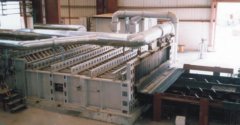Aug 26 2009
SECO/WARWICK USA has entered into a strategic partnership with SECO WARWICK Allied Pvt. Ltd. (India) to offer H2-HC (High Convection) Hydrogen Bell Annealing and Steel Reheat Furnaces in the US, Canada and Mexico.
 Pusher Reheat Furnace
Pusher Reheat Furnace
SECO WARWICK Allied has been designing and manufacturing equipment for the steel industry since 1971. SECO/WARWICK Corp. will adapt this technology for the NAFTA region and manufacture the equipment in their 110,000 square foot USA facility.
According to SECO/WARWICK Corp. President, Keith Boeckenhauer, "The combination of SECO/WARWICK Corp.'s long experience in furnace design and manufacture, and the proven process technologies of SECO WARWICK Allied, will enable us to supply high value, world class equipment to the NAFTA region steel industry."
Kailash V. Nasta, VP, SECO WARWICK Allied, stated, "We look forward to providing our up-to-date technology that meets international performance standards at competitive prices to steel manufacturers throughout the NAFTA region."
H2-HC Hydrogen Bell Annealing
SECO WARWICK Allied has designed and manufactured over 200 H2 Annealing bases up to 120 metric ton capacity. The H2-HC system may be used for both wide and narrow width coils using cracked NH3/H2 gas as a protective atmosphere. The system uses high convection heat transfer with hydraulic clamping and mechanical locks for safe operation. Dehumidification and coil cooling & storage systems are available. High convection heat transfer provides optimum temperature uniformity, which, in turn, produces a higher he quality crystalline structure, reduced decarburization and homogeneous physical properties of the annealed material.
Reheat Furnaces
Reheat furnaces may be configured as rotary hearth, pusher, walking hearth or walking beam for billets, ingots, blooms and slabs. These high efficiency systems are fully automated for ferrous, alloy, non-ferrous or stainless steel material. The furnaces are custom engineered to ensure safe and efficient product movement throughout the continuous furnace. The furnaces are highly fuel efficient due to the roof profile, zone distribution, optimum pre-heating, recuperative zone lengths, proper burner/flue port locations and good instrumentation including furnace chamber pressure control eliminating atmosphere air ingress all of which work together to reduce scale loss and decarb of the charge.